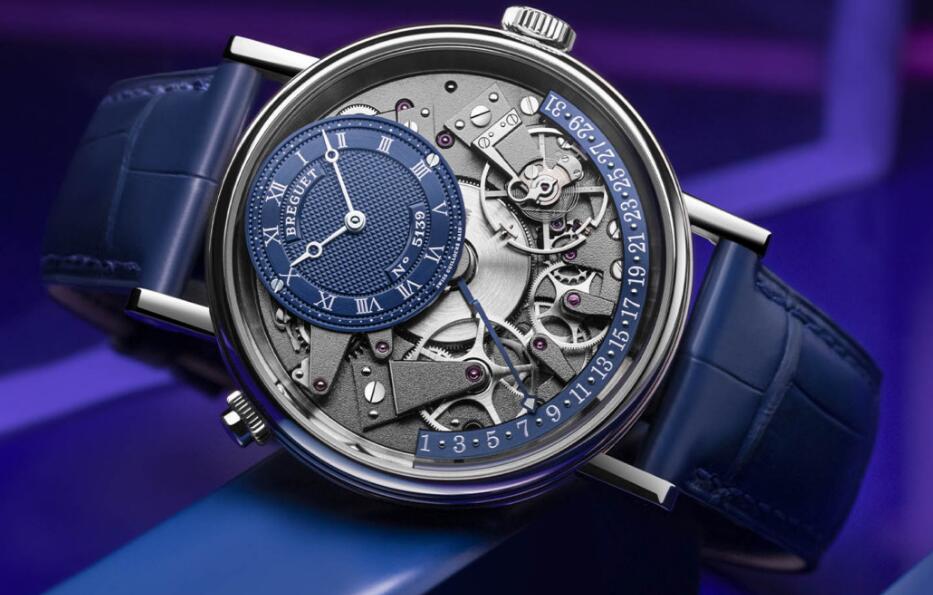
The latest Tradition watch in modern blue.
Vintage style fake watches review are part of the industry and have been highly sought after for about a decade. But when it comes to evoking memories of the past, few are better and more historic than the Breguet heritage. A tribute to Souscription watches of the late 18th century, the heart of the Tradition is the exposed structure of its movement. Several mechanical changes were released, the latest model being the 2020 Tradition Quantième Rétrograde 7597, and today the brand is releasing it in a new colour combination, with a white gold case and a surprisingly bold and modern (at least by the brand’s standards) blue color dial.
While Breguet often draws inspiration from vintage pocket watches to create recognizable displays of its contemporary timepieces, the Tradition collection goes deeper, or at least goes in a different direction. The Tradition watch collection was born in 2005 as a tribute to AL Breguet’s souscription pocket watches. After the French Revolution, he needed to create a new business model that would make watches easier to use while also strengthening the company’s cash flow (not very sexy, but that’s the reality behind the concept). He came up with the concept of subscription watches in 1796, an early version of mass production maintained through crowdfunding. The idea is to get a potential customer to make an initial down payment or subscription, to finance the construction of a relatively simple pocket watch with a large diameter, one hand, a simple movement and a very modest price. This, in turn, would ensure that Breguet could buy parts and build a production line to produce watches in identical batches.
The beauty of the subscription watch is its simple movement construction, which fake Breguet included in his first YTO watch in 1799. The movement is built around a central mainspring with symmetrically constructed finger bridges – balanced to echo the central wheel of the gear train. When the brand launched the Tradition collection in 2005, the idea was to show it below the dial of Breguet’s souscription watches Some original components of the movement. However, the bridges, gears, escapement and barrel are not displayed on the caseback, but are placed on top of the baseplate for viewing from the dial.
Following several different watches, such as manual winding; GMT; automatic retrograde seconds; chronograph; Quantième…a fancy French word for a date complication. But Breguet is Breguet, and it is more than a simple date window. Based on the Automatique Seconde Retrograde 7097, it shares the same basic movement with the self-winding mechanism, but without the retrograde seconds, which has been replaced by a new date function on a dome from 4 o’clock to 7 o’clock. New for this year is the Tradition Quantième Rétrograde 7597 with the addition of a blue version, echoing the Seconde Rétrograde 7097 Blue ‘Boutique Edition’ we are showing here.
The basics remain the same. 40mm high and 12.10mm 18k white gold case in typical Breguet style with thin polished bezel, finely grooved baseband and individually welded lugs with screw rods at the ends to secure the strap. The watch has sapphire crystals on both ends and is water resistant to 30 meters (who wants to see this watch underwater anyway…) For this occasion, the watch is worn on a dark blue alligator leather strap with a clasp Matching pin buckle closure. case.
The change this year is color. The movement retains its anthracite-coated hammer plates and bridges, with contrasting polished bevels, and all wheels and moving elements are rhodium-plated for contrast. The eccentric guilloche dial is made of solid gold and hand-finished on an engine-turned machine, here rendered in blue with the Roman numerals and logo in silver transfer. The open Breguet hands are also silver. The beautiful date track is also blue, and the numbers alternate between silver powder transfers and gold cabochons.
Although simple at first – the date mechanism is often considered the simplest complication – the Breguet Tradition Quantième Rétrograde 7597 features some mechanical improvements. Due to the architectural concept of this movement and its many parts, a retrograde date may be the best choice. The complications are unobtrusive and respect the symmetry of the movement. The date can be corrected quickly thanks to the screw pusher at 10 o’clock. In addition, the shape of the central date hand made of blued steel is also unique. In order to pass the balance and center wheel, it had to be shaped by hand before being heat-blued.
The back shows the automatic in-house calibre 505Q, with its real gold rotor echoing the winding quality found on earlier Perpetuelle pocket watches, however, it now rotates in a classic 360-degree rotation. The movement is modern, and despite its modern appearance, it has a reverse in-line lever escapement with silicon horns, and a Breguet hairspring, also made of silicon – both of which are antimagnetic. Operates at 3Hz with a power reserve of up to 50 hours.
TECHNICAL SPECIFICATIONS – Breguet TRADITION QUANTIÈME RÉTROGRADE 7597
Case: 40mm diameter x 12.10mm height – 18k white gold case – polished with slotted strap – welded lugs with screw bars – sapphire crystal front and case back – push-button date adjustment – 30m water resistance
Dial: 18k solid gold, blue, hand-operated engine – hour markers, Roman numerals – blued steel open Breguet hands
Movement: In-house Caliber 505Q – Automatic with gold central oscillating weight in historic movement style – 14.5″ lignes – 45 jewels – 6 position adjustment – 50 hour power reserve – reverse in-line lever escapement with silicon horns Longitudinal mechanism, Breguet silicon balance spring – 21,600 vibrations/hour – Off-centre hours and minutes, retrograde date – Movement finished in historic style with hammered bridges
Strap: Blue alligator leather strap with gold pin buckle
Reference: 7597BB/GY/9WU
